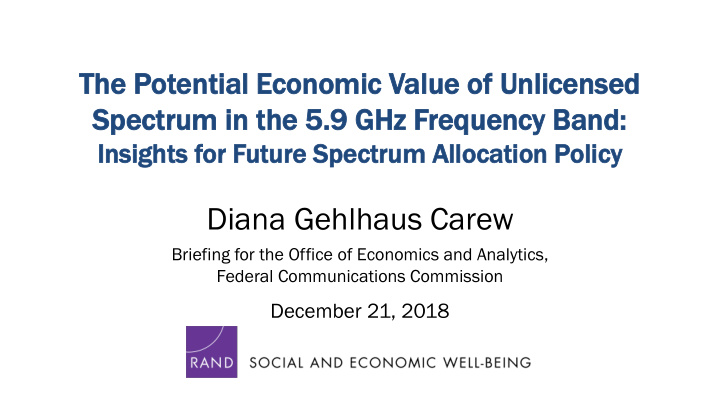



The he Potential ntial Eco conomic nomic Val alue ue of of Un Unlice licensed nsed Sp Spect ctrum rum in the in the 5. 5.9 GHz 9 GHz Fre requ quency ency Ba Band: nd: Ins nsig ights hts for r Future re Sp Spec ectru trum m All lloca cation tion Poli licy cy Diana Gehlhaus Carew Briefing for the Office of Economics and Analytics, Federal Communications Commission December 21, 2018
RAND RAND is a nonprofit, non-partisan research organization dedicated to developing solutions to public policy challenges to help make communities throughout the world safer and more secure, healthier and more prosperous. RAND-NOT FOR CITATION OR DISTRIBUTION 2
Agenda • Motivation • Our Approach • Assumptions and Limitations • Trade-off with DSRC • Detailed Methods • Allocation Alternatives • Conclusion RAND-NOT FOR CITATION OR DISTRIBUTION 3
Motiv ivation • Large increase in WiFi data traffic and forecasted demand • Reports of looming unlicensed spectrum crunch • Questions about approach to unlicensed spectrum allocation • Specific questions about 5.9 GHz band facilitated study • Intended contribution to the general discourse RAND-NOT FOR CITATION OR DISTRIBUTION 4
Our Approach • Started by asking about value if band reallocated for open use • Next asked what about this band creates value • The 5.9 GHz band could create potential value in two ways • Consumption-focused across all people, devices, applications • Emphasis on residential consumption excludes enterprises • Focus on measuring direct value, not intangible value of information RAND-NOT FOR CITATION OR DISTRIBUTION 5
Assumptions and Lim imitations • Because of the nature of spectrum, there are many assumptions • Spectrum not homogeneous good • Marginal value is not constant and changing over time • Lots of proxies and imperfect data, using best data available RAND-NOT FOR CITATION OR DISTRIBUTION 6
The Trade-off wit ith DSRC • Potential value of DSRC similarly a difficult question • Currently evidence that market value is small but did not study • Some auto manufacturers are using cellular networks, and device manufacturers are designing products for both • Much of the potential value likely stems from reduced fatalities and accidents • We do not subtract out the potential value of DSRC from our estimates RAND-NOT FOR CITATION OR DISTRIBUTION 7
Contribution to GDP – Approach 1 • Focus on benefit of 160 MHz channel • First estimated a new elasticity for returns to speed: • Second, converted to estimate appropriate for large changes in speed • Third, applied Katz (2018) methodology for estimating GDP contribution from speed differential between cellular and WiFi networks • Estimated a range, given differential between 80 MHz channel data rate, 160 MHz channel data rate, and status quo RAND-NOT FOR CITATION OR DISTRIBUTION 8
Approach 1 - Estimates Scenario A = 20 MHz channel; Scenario B = 40 MHz channel; Scenario C = 80 MHz channel; Scenario D = 160 MHz channel RAND-NOT FOR CITATION OR DISTRIBUTION 9
Contribution to GDP – Approach 2 • Focus on additional 75 MHz of data capacity • First, used Nyquist Theorem which relates data capacity, bandwidth, and modulation scheme (QAM): • Second, estimated how many devices could stream data on 75 MHz, using both load share (data traffic allocation) and device share (device allocation) • Third, monetized in terms of residential internet revenues, taking the estimated share that is WiFi, and in terms of device revenues, using averages prices • Scaled to number of internet-enabled households in the United States RAND-NOT FOR CITATION OR DISTRIBUTION 10
Approach 2 - Estimates • Using device traffic load share: $105.8bn • Using total device share: $71bn RAND-NOT FOR CITATION OR DISTRIBUTION 11
Consumer Surplus (C (CS) & Producer Surplus (P (PS) • CS estimated over three channel sizes using: • WTP for an additional Mbps from the literature (Nevo 2016) • Residential WiFi share of total WiFi consumption • Number of Internet-enabled households ➢ Estimate CS range between $65bn and $172 billion • PS estimated using per-MHz revenue from the FCC 2016 Incentive Auction ➢ Estimate PS to be about $18bn RAND-NOT FOR CITATION OR DISTRIBUTION 12
All llocation Alt lternatives • All affect realization of potential economic value: • Status Quo • Partial Sharing • Co-channel • Adjacent • Full Reallocation RAND-NOT FOR CITATION OR DISTRIBUTION 13
Conclusion • All together, we estimate the potential economic value of the 5.9 GHz frequency band as: RAND-NOT FOR CITATION OR DISTRIBUTION 14
Questions? Thank You! dcarew@rand.org Check out the report online: https://www.rand.org/pubs/research_reports/RR2720.html RAND-NOT FOR CITATION OR DISTRIBUTION 15
Backup Slides RAND-NOT FOR CITATION OR DISTRIBUTION 17
Approach 1 – Regression Model Specifications RAND-NOT FOR CITATION OR DISTRIBUTION 18
Approach 1 – Regression Analysis RAND-NOT FOR CITATION OR DISTRIBUTION 19
Approach 1 – Contribution Calculation RAND-NOT FOR CITATION OR DISTRIBUTION 20
Approach 2 – Data Traffic Load Share RAND-NOT FOR CITATION OR DISTRIBUTION 21
Approach 2 – Device Share RAND-NOT FOR CITATION OR DISTRIBUTION 22
Consumer Surplus Calculation RAND-NOT FOR CITATION OR DISTRIBUTION 23
Other Policy Impacts RAND-NOT FOR CITATION OR DISTRIBUTION 24
Recommend
More recommend